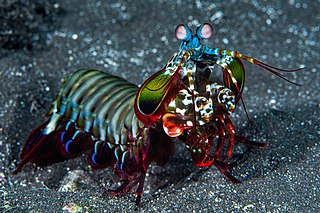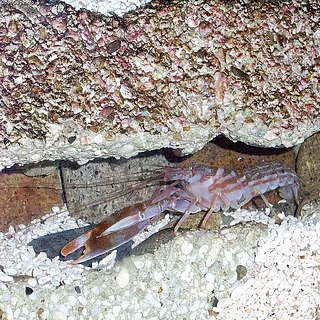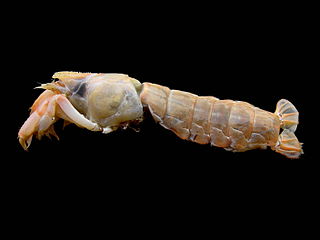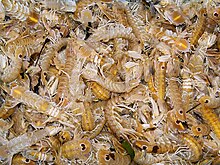
Mantis shrimp are carnivorous marine crustaceans of the order Stomatopoda. Stomatopods branched off from other members of the class Malacostraca around 340 million years ago. Mantis shrimp typically grow to around 10 cm (3.9 in) in length, while a few can reach up to 38 cm (15 in). A mantis shrimp's carapace covers only the rear part of the head and the first four segments of the thorax. Varieties range in colour from shades of brown to vivid colours, with more than 520 species of mantis shrimp known. They are among the most important predators in many shallow, tropical and subtropical marine habitats. However, despite being common, they are poorly understood, as many species spend most of their lives sheltering in burrows and holes.

Odontodactylus is a genus of mantis shrimp, the only genus in the family Odontodactylidae. Mantis shrimp of the genus Odontodactylus can not only detect circular polarisation of light, but can also detect polarised light reflecting off their telson and uropods.

Alpheidae is a family of caridean snapping shrimp, characterized by having asymmetrical claws, the larger of which is typically capable of producing a loud snapping sound. Other common names for animals in the group are pistol shrimp or alpheid shrimp.

Odontodactylus scyllarus, commonly known as the peacock mantis shrimp, harlequin mantis shrimp, painted mantis shrimp, clown mantis shrimp or rainbow mantis shrimp, is a large stomatopod native to the epipelagic seabed across the Indo-Pacific, ranging from Guam to East Africa, and as far South as Northern KwaZulu Natal in South Africa.

Potamalpheops is a genus of shrimp in the family Alpheidae. It was originally erected by Powell in 1979 to house species from Africa. Later, Horton H. Hobbs, Jr. realised that the troglobitic shrimp he had described in 1973 from Oaxaca, Mexico as Alpheopsis stygicola, also belonged to the genus, and in 1991, A. J. Bruce described a new species from Australia, further expanding the genus' geographical range. It is now thought to represent a relict taxon from the Tethys Sea.
Rissoides desmaresti is a species of mantis shrimp native to the eastern Atlantic Ocean and Mediterranean Sea.

Upogebia deltaura is a species of mud lobster from the Atlantic Ocean and Mediterranean Sea.
Platysquilla eusebia is a species of mantis shrimp in the family Nannosquillidae, from the Mediterranean Sea and north-eastern Atlantic Ocean. It is a spearer, and grows up to 7 cm (2.8 in) long.

Lysiosquillina maculata, the zebra mantis shrimp, striped mantis shrimp or razor mantis, is a species of mantis shrimp found across the Indo-Pacific region from East Africa to the Galápagos and Hawaiian Islands. At a length up to 40 cm, L. maculata is the largest mantis shrimp in the world. L. maculata may be distinguished from its congener L. sulcata by the greater number of teeth on the last segment of its raptorial claw, and by the colouration of the uropodal endopod, the distal half of which is dark in L. maculata but not in L. sulcata. A small artisanal fishery exists for this species.
Aeschronectida is an extinct order of mantis shrimp-like crustaceans which lived in the Mississippian subperiod in what is now Montana. They exclusively lived in the Carboniferous, or the age of amphibians. They have been found mostly in the U.S. and in the British Isles, in 1979 species were found in the Madera Formation in New Mexico. Aeschronectida was first identified appearing in Continental Europe in around 2014. While sharing similar characteristics to Stomatopoda, they lack certain physical characteristics of that taxon. The first species of Aeschronectida is accredited to Frederick R. Schram. They diverge substantially from typical hoplocaridan morphology by having more unmodified thoracopods. It's theorized that these thoracopods evolved to become more specialized, making them potential ancestors to Stomatopoda.

Boman Framji Chhapgar was an Indian marine biologist who specialized in carcinology. The author of popular accounts on marine biology under the pen-name of "beefsea", several new species of crab, mantis shrimp and fishes have been described by him.

Gelasimus vocans is a species of fiddler crab. It is found across the Indo-Pacific from the Red Sea, Zanzibar and Madagascar to Indonesia and the central Pacific Ocean. It lives in burrows up to 50 centimetres (20 in) deep. Several forms of G. vocans have been recognised, with their authors often granting them the taxonomic rank of full species or subspecies.

Albunea carabus is a rare species of "sand crab" or "mole crab" in the genus Albunea. It lives in shallow, turbulent waters in sandy areas of the tropical eastern Atlantic Ocean and the Mediterranean Sea.
Squilla empusa is a species of mantis shrimp found in coastal areas of the western Atlantic Ocean. It excavates and occupies a burrow in soft sediment from which it emerges, mainly at night, to feed on fish and invertebrate prey.
Automate branchialis is a species of pistol shrimp from the family Alpheidae which was thought to be a Lessepsian migrant, i.e. a species which had colonised the Mediterranean from the Red Sea via the Suez Canal. This was because before its description in 1958 all the species of the genus Automate were found in the Indo-Pacific region. A. branchialis has not been recorded in the Indo-Pacific region and has been found to be widespread in the Mediterranean so it is now considered to be a Mediterranean endemic.

Acanthosquilla is a genus of stomatopod crustacean. The American carcinologist Raymond B. Manning named and first circumscribed the genus in 1963. As of 2018, the World Register of Marine Species recognizes the following eight species:

Acanthosquilla derijardi is a species of stomatopod crustacean. Its distribution is widespread throughout the Indo-West Pacific. The species was initially described by the American carcinologist Raymond B. Manning in 1970. Its junior synonym, A. sirindhorn, was named in 1995 in honor of Princess Sirindhorn of Thailand.

Gonodactylus chiragra is a medium to large mantis shrimp that is distributed widely throughout the West Indo-Pacific.
Alima neptuni is a species of shrimp in the Squillidae family, and was first described in 1768 by Carl Linnaeus as Cancer neptuni.
Athanas sydneyensis is a species of small alpheid shrimp.














